Where Nature Stores Her Jewels
A Study of San Diego, California, and Its Marvelous Natural Resources
By Edna Rowell Schley
The following article was published in the October 1905 edition of Sunset Magazine, pages 544–555.
 |
Were a fatidic finger to trace upon the thin wall veiling the future the name of that California city most likely to rise above its present status in a decade, probably that name would be San Diego. That this city, close to the border of romantic Mexico, is to be a fine factor in the next chapter of western history is as certain as is western progress.
A hundred years ago the fair site of a friar mission; eighteen years ago a village of 300 people; seventeen years ago a booming town of thousands; today a city of 25,000 residents with a floating population—visitors with money in their pockets—of 7,000; tomorrow one of the great ports of the fast developing southland—that’s San Diego. Its soil is fruitful and tropical. Its climate is so fine and so equable that eastern visitors paddle in the waves from January to December and dispute as to whether it be a summer or a winter resort. The government, recognizing its commercial destiny and its naval importance has gladly spent millions for dredgers and a jetty to make the gate to its fine landlocked harbor second only in depth to the harbor of New York. The government is planning to build its great western coaling-station there. On its peninsula, Coronado, stands one of the largest tourist hotels in the world. The population of the city of San Diego has increased forty per cent since the census of 1900. Its commercial enterprise has increased one hundred per cent in two years. In May, of this year, capitalists subscribed $1,000,000 to build a great hotel on the mainland. In twenty-four hours residents who read the signs of the times had subscribed the money to build four new business blocks solidly about the hotel site. And this in a little city recently looked upon as a balmy spot by a sleeping sea where education and morality were realities, and where those with their fortunes made might come to grow roses.
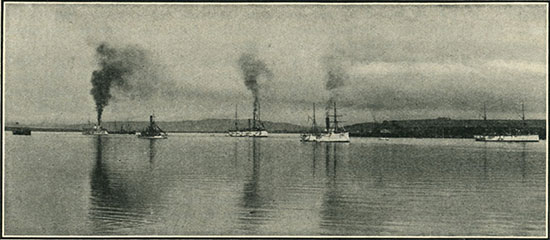 |
| Fleet of the United States Navy in San Diego Bay. |
The modern city of San Diego was founded by A. E. Horton, in 1867, and is therefore still in its infancy. Having at present a population of 28,000, it but remains for the enterprise of man to make this city of wonderful natural advantages, one of the commercially great centers of the world. Ideally situated, on hills that gradually rise from the beautiful bay, its sanitary conditions are naturally perfect. Numerous wharves extend into the bay, and near them, are located the lumber yards, warehouses, foundries and heavier wholesale and manufacturing interests. Then come the retail business blocks, many of them splendid structures, and beyond, spreading out over the gently undulating hill-land is the residence portion of the city. To the south and west, the bay; Point Loma, and the grand Pacific spread out, in a magnificent panorama, while to the east, the hills, rising gradually to the high timbered peaks of the Coast range, complete a scenic effect that is unparalleled.
 |
| Panoramic view of San Diego Bay, showing the city of San Diego, Coronado Peninsula, and the entrance to the harbor, looking south from Fort Rosecrans. |
The water supply of San Diego is abundant and pure, coming direct from the Cuyamaca mountains, 5,000 feet above sea level; the supply and distribution being controlled by the municipality. Well-lighted streets and a splendid modern railway system, add to the pleasure and comfort of the resident and visitor. The schools, public and private, are excellent. Here, one of the finest Normal schools in the country was recently completed, at a cost of $150,000. Located on an eminence, it commands a magnificent outlook. Surrounding it, on University Heights, are most artistic homes, whose semi-tropical gardens are a delight to the winter visitor from the ice-bound eastern states.
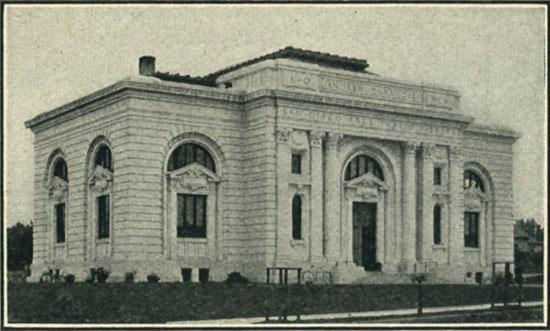 |
| Public library building, San Diego. (Photo: Fitch Studio) |
This city was the recipient of a most generous gift from Andrew Carnegie—a library—costing $85,000. The design is classic and it is altogether a fitting home for the 23,000 volumes of standard books.
Experts declare that the section of forty square miles upon which the city of San Diego is located, has the most equable temperature known to any mainland. According to a bulletin issued by the Department of Agriculture, the portion of San Diego county, thirty to fifty miles east and northeast of the city, has the heaviest rainfall of any part of southern California. The city, however, is blessed with just enough of this to rejuvenate and freshen the atmosphere, making outdoor sports possible the year round. The winter days are filled with sunshine, and the summer is one continuous series of cool, balmy days, tempered by delightful sea-breezes.
 |
| The State Normal School building, on University Heights, San Diego. (Photo: Fitch Studio) |
A tract of land, 1,400 acres in extent, has been set aside as a city park, and its picturesque hills and ravines are being rapidly converted into a wilderness of beauty that will be one of the show places of the country.
Within easy access, are some of the world’s greatest resorts, the combination of mountains and sea offering splendid diversion to the lover of Nature in her varied moods. Coronado, just across the bay from San Diego, is delightful, whether visited in summer or winter. During the entire year, outdoor sports are indulged in comfortably and with pleasure, including yachting, rowing, automobiling, riding, fishing, hunting, golfing, swimming—and the devotees of the games of tennis and polo feel this to be their Mecca, for conditions of weather never interrupt their sport or their enjoyment of the open air.
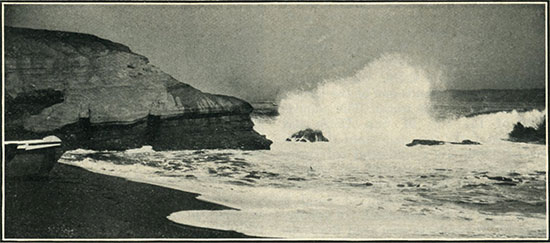 |
| La Jolla is a combination of smooth sea beach and mammoth caves. (Photo: Fitch Studio) |
Points of interest near San Diego and Coronado that are visited for their historic or picturesque attractions, are Tia Juana (the Mexican town across the border), where one may enjoy a dinner of chili-seasoned viands; Coronado islands, some thirty miles off the Mexican coast, huge, barren peaks of granite, one of the group, having the contour of a sarcophagus, and called for that reason, Corpus Christi. California’s oldest mission, established by Junipero Serra in 1769, is still in a state of preservation, protected as it is, in the fertile Mission valley. On Point Lorna, is located the Theosophical Brotherhood. Buildings of classic architecture are surrounded by gardens of semi-tropic loveliness, and an unparalleled view of ocean, bay and mountain lend an indescribable charm that is long cherished by the visitor. La Jolla is a combination of smooth, sea beach and mammoth caves, and the naturally sculptured rocks are a constant wonder to all. The old town was the marriage-place of Ramona, the heroine of Helen Hunt Jackson’s famous novel, and the old adobe, built around a patio, is still there; here too, are the old Mission bells brought in the early days from Spain, and the gigantic palms, 134 years old, stand as monuments to the foresight of the Franciscan padres who planted them.
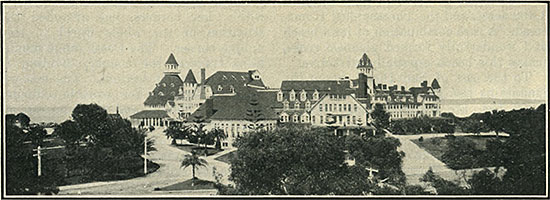 |
| Hotel del Coronado, just across the bay from San Diego * * * delightful, summer or winter. (Photo: Fitch Studio) |
Several beach resorts are within a few minutes’ ride of San Diego; Pacific beach, Ocean beach and La Jolla. Pacific beach is a wonderful strand of hard, firm sand, 600 yards wide and four miles long; it is a great delight to the automobilist, who can here speed his machine to his heart’s content. Ocean beach, on the west side of Point Loma, is close to the government reservation of 1,400 acres, and the Theosophical Homestead. A rare combination of level beach and wonderfully formed gigantic rocks, makes this beach especially attractive.
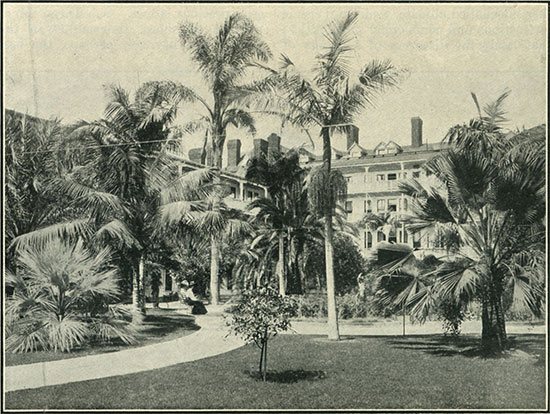 |
| Tropical garden of the patio of Hotel del Coronado. (Photo: Fitch Studio) |
To the east of San Diego, where the mountains rise gradually to a height of 5,000 feet, are scattered many famous mineral springs. Best known are the curative iron and lithia carbonated waters of Buckman’s springs, the sulphur waters of Warner’s and the lithia springs about three miles from the romantic town of Ramona. Palomar mountain, further to the north, is visited by those who love the fragrance and health-giving properties of the gigantic pines and cedars. Near here, too, are the famous Pala mines, and the Indian reservation, where the remnant of the tribe still holds an annual fiesta, and the older ones carry out the weird ceremonies of the snake and fire dances, soon to be only matters of history.
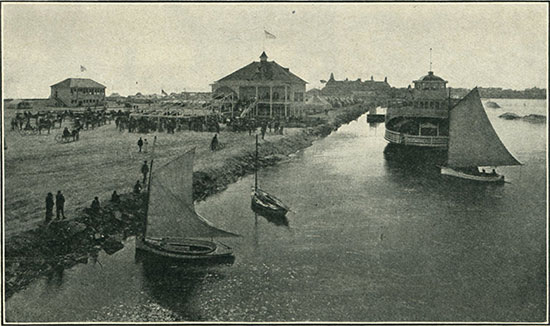 |
| The tent city on Coronado Beach, West of San Diego, where all outdoor sports are indulged in during the entire year. (Photo: Putnam & Valentine) |
In the past, San Diego county acquired fame throughout the world for her unequalled climate, wonderful scenic attractions and commercial possibilities; but lately the discovery of a variety of precious gems, in commercial quantity, within her borders, has attracted the attention of the whole world to this unique corner. The Coast range mountains traverse the county, dividing it into two distinct sections. The western slope is famous for equable climate, fruits and flowers, and the delta region, to the east, watered by the great Colorado river is a land of vast possibilities.
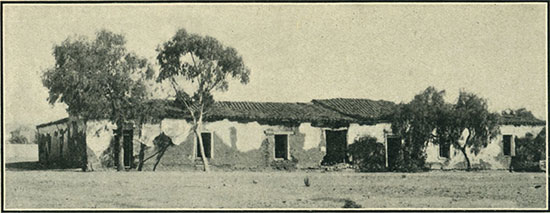 |
| Adobe house at old San Diego, the marriage-place of Ramona, heroine of Helen Hunt Jackson’s famous novel. (Photo: Fitch Studio) |
This mountain chain, which thus divides the valleys, is the county’s great treasure-box, whose riches have been but partially uncovered. For thirty years, the gold mines of this region have been successfully worked, producing many millions in gold bullion from free-milling ores. Although gold-mining is still carried on extensively, it required the recent discovery of precious gems to attract the attention of the world to the vast and varied mineral deposits of this region. Almost every known precious and semi-precious gem has been found, those in commercial quantities being the tourmaline, kunzite, beryl, hyacinth, topaz, garnet, turquoise, and the lesser semi-precious stones. San Diego mines produce the finest tourmalines in the world, and they are, perhaps, the best known and most beautiful of all this galaxy of jewels. This exquisite gem is found in almost every color and combination of colors, perhaps the most popular being the rubellite, which includes every shade of pink and red; then there is the green, or chrysolite, as it is called; indicolite, for the blue, and all the varying combinations of color.
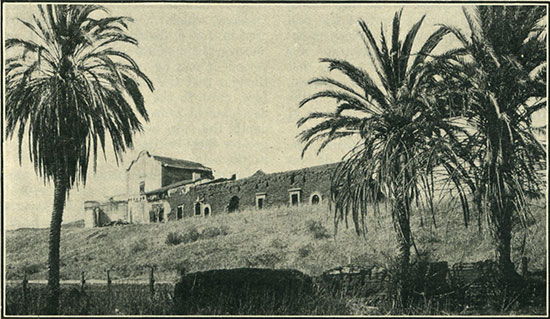 |
| California’s oldest mission, established in the Mission valley near San Diego by Junipero Serra in 1769. (Photo: Fitch Studio) |
The tourmaline crystals are remarkable for their varied and beautiful groupings of colors. Some are internally blue or brown, surrounded by a bright carmine red, or dull yellow; others are red internally, enveloped by a green exterior; crystals are sometimes pink at the summit and green at the base, or crimson, tipped with black or white shading to green, and then to red. No gem enjoys such a suite of colors as the tourmaline. The finest specimens of this gem are found in San Diego county, in the famous Mesa Grande and Pala mountains.
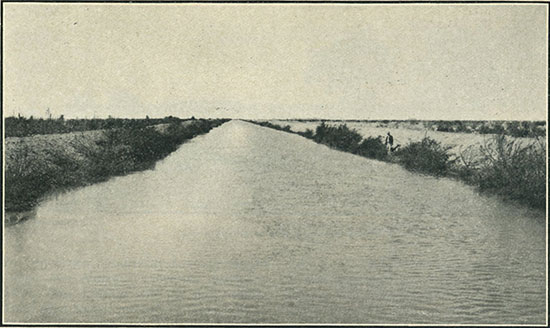 |
| An irrigation canal, San Diego County; canals like these make fertile thousands of hitherto uncultivated acres. (Photo: Putnam & Valentine) |
The story goes that about twenty-five years ago, Indian children, playing around camp in this vicinity, picked up an oddly-shaped stone, about three inches long, six-sided, and about as thick as a lead-pencil, which when cleaned and rubbed, was found to be of a rich, blue color, clear and very brilliant, like a sapphire. This, probably, was the first tourmaline discovered in San Diego county, although the value of the stone was not known to the discoverers.
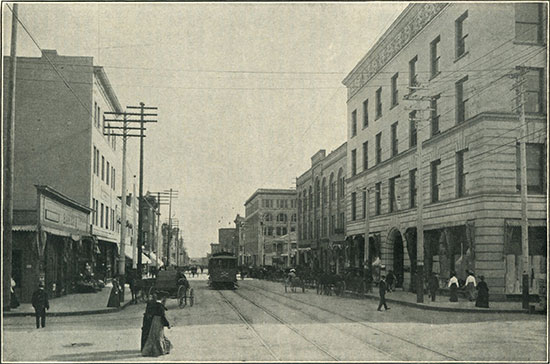 |
| Fifth Street, one of San Diego’s principal business thoroughfares, looking west toward the harbor. Note the substantial buildings, the electric cars, and other evidences of a progressive city. |
It was not until 1898 that the real discovery of these now famed gem mines was made. While prospecting for lepidolite, a blast uncovered a ledge that proved to be a mass of this mineral, which, when examined, proved to be the hiding place of magnificent crystals of tourmaline, the rubellite variety predominating. Unlike other localities, the tourmaline found at Mesa Grande was found to be in distinct, isolated crystals, with perfect prisms and terminations. Its hardness is 7 to 7.5; specific gravity, 3. If heated or rubbed, the tourmaline becomes electric, and will attract small objects.
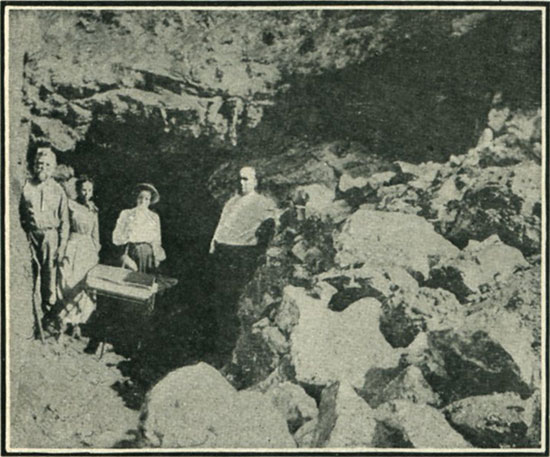 |
| Where topaz and tourmaline are mined. (The writer of the accompanying article is at the tunnel entrance.) |
Beside the pink tourmaline, there is also a large number of parti-colored crystals found, some made up of three, four or five distinct sections. The tourmaline belt of Mesa Grande follows that of the lepidolite region of the Palomar mountains, and the close association of this lithia mica with the colored lithia tourmalines leads to a belief that there may prove to be a zone of these valuable and interesting minerals traversing this region. The crystals are found in a vein of mingled quartz, lepidolite and feldspar, which, in places, is exposed by erosion for a distance of 300 feet or more on the mountain side. In the early period of mining in this region, it was thought that the gems lay near the surface, close to the sunlight, but further development proved that the greater the depth, the more beautiful the gems; the greater their brilliancy, the more exquisite the color.
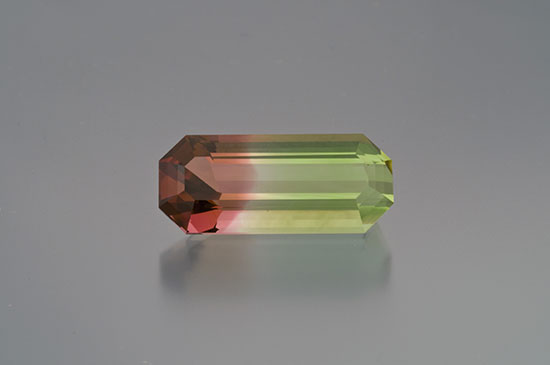 |
| Tre colori. Technically known as a bi-color, this 16-carat tourmaline from the Himalaya mine features an exquisitely undulating red, white and green—like the Italian flag. (Photo: Jason Stephenson) |
In 1901–02, San Diego county produced more tourmalines than the rest of the world, and it is claimed by experts that the gems found there are the finest produced. The Siberian tourmalines have been sold for rubies for years, but they are not as brilliant as the gems from San Diego county. As it is not necessary to handle any waste, the cost of working these gem-mines is less than any other class of mining.
In addition to tourmaline, a new gem, kunzite, found in no other part of the world, was recently discovered. The Pala mines of San Diego produce, perhaps the finest specimens, shading from a white, brilliant gem, through the pale lilacs to an almost deep violet. This wonderful gem has excited the admiration of all connoisseurs.
Just over the border, in Riverside county, in the Coahuilla mountains, another discovery of kunzite has lately been made, in a very wonderful ledge of quartz, in which is imbedded, besides garnets, beryls and the rare blue tourmalines.
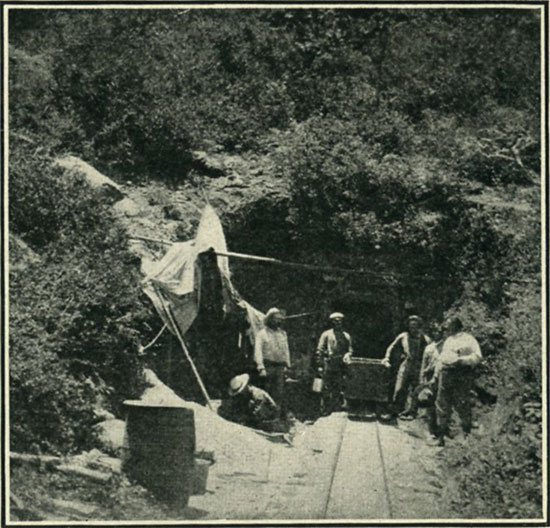 |
| At the entrance to a tunnel of a San Diego tourmaline mine. |
Of the other gems, perhaps the most beautiful is the hyacinth, of the zircon family, which, when cut, rivals the diamond in brilliancy. The true hyacinth is the zircon of red color, and the yellow zircon is named the jacinth. Brown, violet and green colored crystals are also found belonging to this same class; the yellow-brown gems being particularly beautiful, and wonderfully brilliant. The spessartite-garnet, but lately found and classified, is implanted on a garnet rock in brilliant crystals. These are unusually translucent, and when cut, possess great fire and brilliancy.
Then there is the beryl, found in pink, green and white. When this stone is found in the grass-green color, it is the emerald, one of the most highly prized of stones. This color of beryl is usually filled with flaws, and a perfect emerald of large size, is therefore difficult to obtain. When light blue, the beryl is known as aqua-marine; when greenish-blue, it is the Siberian aqua-marine; and when it is greenish-yellow, it is called aqua-marine chrysolite. Under an artificial light, these varieties are unusually brilliant. Then there is the golden beryl very much admired, and a pink variety, which is a very rare form. The deposits of beryl have not as yet been thoroughly developed, and it is believed that true emerald beryl will be uncovered as depth is reached.
Another gem found in commercial quantities is the topaz, in the white, blue and yellow varieties. The blue is particularly valuable on account of its very rare form. Beryl and chrysolite are distinguished from topaz by weight and hardness, beryl being much lighter and topaz much harder.
The indications also favor the belief that the diamond and true ruby will yet reward the prospector.
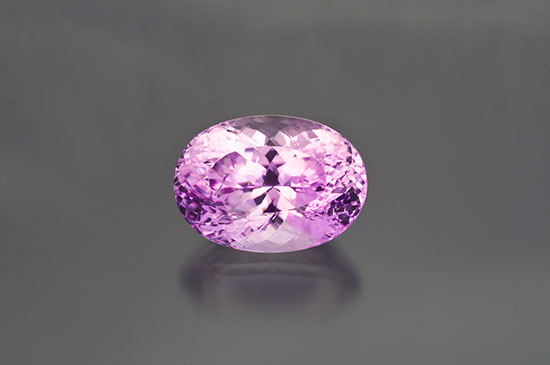 |
| Kunzite, 57 carats, from the Oceanview Mine. (Photo: Mia Dixon) |
The minerals of this favored county, beside gold and silver, are numerous; there being copper, lead, galena, zinc, iron, kaolin, cement, aluminum, asbestos, fire clay, fuller’s earth, gypsum, limestone, manganese, mineral paint, mica, graphite, sulphur, salt, marble and mineral waters. The marble deposits are wonderful, producing the much sought after pink and green varieties. In this county is located the largest lithia mine in the world.
On the east side of this range, that contains a glory of precious stones and minerals, lies the far-famed Imperial valley. This is watered by the great Colorado river, diverted by man’s ingenuity into this wonderfully fertile delta. This section bids fair to become the leading stock and dairy section of the great southwest. The grain crop of 1905 is estimated at 300,000 sacks, while many thousand tons of hay swell the wealth of this favored region.
Down the western slope, stretching to the sea, is a succession of productive, fertile valleys, the home of the olive, lemon, pomelo, raisin-grape, and deciduous fruits. With the completed reservoirs at Sweet Water, having a capacity of 5,882,278,000 gallons, and Escondido reservoir with a 3,703,000,000 gallon capacity, this section will be one of the best irrigated in the country.
On the table lands, around Mesa Grande and Campo, great herds of cattle roam this fertile, well-watered range, and their sleek appearance speaks well for the quality of the feed they thrive on.
The foothill country is the ideal home of the olive, and the equable climate seems to favor even the making of the oil and canning of the fruit. Since the founding in 1769 at San Diego, by the pious old priests, of the first of their chain of missions, the county has always been prominent in the olive industry. The trees planted by the padres were the foundation of the present great industry. The business of growing and curing olives, and of making olive oil, has, since those early days, always been associated with this city by the sea. The fame of San Diego olives and olive oil has stretched out far beyond the borders of California, even into Europe, supposed to be the stronghold of the olive. Products of this far-off county captured gold medals at Paris and Lille, France, and London, England. A great impetus has been given this industry in recent years by the introduction of a process for canning ripe olives, and so putting on the markets of the east, a delicacy which has hitherto only been obtainable close at home.
The orange, lemon and pomelo are raised successfully, and now that the waters of the mountains have been impounded and directed into channels where needed, the fruits of this county will without doubt take their place among the first in the land, as to quality and quantity. In one lemon grove of 800 acres, about eight miles south of San Diego, 32,750 boxes, making 105 carloads, were shipped to different points last year. This was in addition to 133 carloads consumed by the citric acid factory in the preparation of products.
In the Escondido district and the valley of El Cajon, raisin grapes are the principal crop. Most of the vineyards are grown without irrigation, although where irrigation is in force, the crop is largely increased by it. In these foothills, the home of the sweet-scented sage blossom, numerous apiaries are located, and the honey is noted for its delicious perfume and fine flavor. This product commands a ready market, at top prices.
It is not improbable that the near future will find San Diego county with a new industry—the cultivation of the silk-worm. The climatic conditions are perfectly adapted to the delicate constitution of the worm, and the foliage of the mulberry tree may be had in wholesome condition, practically during the entire year.
The novel display of San Diego’s rare and beautiful gems at the Lewis and Clark exposition, Portland, Oregon, has excited the admiration of all who have had the good fortune to see it; and this, perhaps, was instrumental in pointing the way for the vast throng of people who visited San Diego during the summer.
Called the Naples of the southwest, San Diego has taken the place that is rightly hers, one of the foremost cities in the great western empire. With a steadily increasing permanent population, besides a great influx of summer and winter tourists, a prosperous future is assured this ideally situated city.